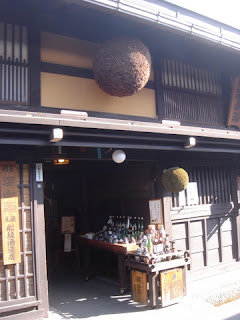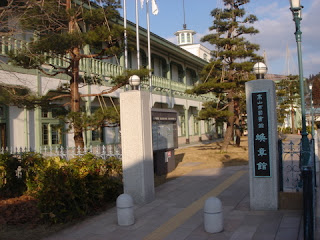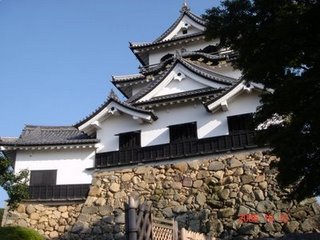This time, I would like to show some pictures that I took at Jinnya in Takayama city.
There're some museums and tourist attractions in Hida area, and the majors are Takayama-Jinnya that I want to describe this time and Festival Floats Exhibition Hall on next blog would be the best in the area. If you'll visit Hida-Takayama, I guess that you'll enjoy them well!
At first, I need to explain about Jinnya. Jinnya was a magistrate's office in the Edo period. So, this Takayama Jinnya was also built when Tokugawa shogunate started to manage Hida area in the Edo period and then it was used for their administrative organ. At that period, Hatamoto who were direct retainer of the shogun came from Edo to control the area as Daikan who were local magistrates. So Jinnya is a bit special building and it's also unique from other building in the fact that people worked at the Jinnya with differs in social standing.
By the way, there were more then 60 Jinnya in Edo period, but now there is only Takayama Jinnya in the point keeping origin building. Of course, some of the parts were restored.
Well, I put my pictures on this blog with my explanations about Takayama Jinnya.

The first picture is the gate of the Jinnya. In Edo period some gatekeepers were standing in front of the gate, but now the place changes to pay our entrance fee. The fee is 420 Yen for an adult and we can enjoy explanations by the member of the staff of Jinnya free! We felt the fee was very cheap! But, the explanations are described in Japanese only, so it's not so helpful for international people.

The Jinnya was the bit special place for people who had several kinds of social standings, which were Hatamoto from Edo, local public functionaries and people who weren't Samurai.
I took the picture of the office to show the interesting fact. Can you guess? There are two rooms on this picture, and front one is for Hatamoto and the other is for local public functionaries. And we can understand the difference by the borders of Tatami. We can find any patterns on the borders at front room, but the other was just black, right?

And there are some entrances for each social standing, even if the building is only one. This entrance was for local public functionaries. The different entrances were very small for the worker who weren't samurai, and they look ordinary.

It is a bathroom. In Edo period, the workers used to wash their body here. On the other hands, there were also cultures using bathtubs in other area. So cultures depended on the area in Japan.


This is the room for their special guest who usually came from Edo. And this room is the best to enjoy the Japanese garden of the Jinnya.

This room is one of the biggest rooms in Jinnya, and it is for the family of the Hatamoto to live in. This room has a Tokonoma that is a Japanese alcove with very beautiful Kakejiku that is Japanese hanging picture. And we could also enjoy Japanese garden from Engawa that is Japanese veranda and I describe it after with a picture.

In Edo period, all of Japanese buildings were built with wood and the Jinnya is also same. So they really care about fire. This is the reason of the waterways between buildings like this picture, and the waterways also have the function to take the water after snow melted to river in Hida area. I took this picture in January, but we can see few snow....it's too warm in this winter.

We could find some parlors in Jinnya. This parlor was for people who weren't Samurai to take rest with the Irori that is Japanese open hearth.

This is the kitchen on Jinnya. This furnace is on the floor boarded up, so the meals cooked with the furnace were for the family of Hatamoto came from Edo.

And the furnaces on the ground were for the meals of other people. We can also find the fact that the ceiling is higher than ones in other rooms, right?

And this is the washroom made in wood and Japanese style.

After washroom, they washed their hands here. It's looks Japanese style.

This is the Engawa that is Japanese veranda. We don't use it as only veranda, but we also use it as passageway.

This is the great hall. If they had any audience, they used the room.

This is basketwork to ride on for the people of high rank. The color and the ornament of basketworks depended on the social standing and/or the distinction of sex.
Can you guess? How to move by it? Some people carry the bar of the basketwork on their shoulder.

This area is Shirasu that is Japanese law court where suspects and witness were summoned before a magistrate.
And now, some torture items are exhibited here. Basically Hatamoto didn't have enough judicial power, so finally suspects were sent to Edo and then to get their judgment.

This is a Dozo that is Japanese storehouse covered with clay. I wanted to take some pictures in the Dozo, but it was prohibited so I gave it up. The inside is museum with the structure kept since Edo period. So inside was made with wood.
In this connection, the means of the word ‘Dozo' is a storehouse covered with clay in Japanese language. And the roof looks made with wood, but the roof just put on the Dozo. So if the Dozo is caught in a fire, the clay doesn't burn and it protects the inside from the fire.
How do you think?
We really enjoyed the Jinnya for one and half hours with a member of the staff. So Jinnya is very good tourist attraction.
I must recommend you to visit there, when you travel in Japan.
We can check the information about Hida Takayama!
Hida Takayama in Gifu







































